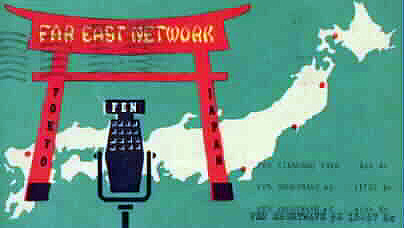The History of FEN - Tokyo
FIFTY YEARS AND COUNTING
FEN Tokyo first began radio broadcasting as "WVTR" September 12,
1945 and continues to operate more than 50 years later as a provision
of the Status of Forces Agreement.
As originally conceived, the Far East Network, part of the Armed
Forces Radio and Television Service, covered the entire Pacific Rim
region including Japan, Okinawa, Taiwan, Korea, the Phillipines, and
a number of Pacific islands. During the 1960s, broadcasts for Japan
originated from studios located on South Camp Drake near Tokyo. The
signal was transmitted over a powerful 10,000 watt AM station located
at 810 on the AM dial. FM radio in Japan has a unique history all of
its own, but suffice it to say that FEN was never allowed to
broadcast an over-the-air FM signal. The same was true for television
(at least in the Tokyo area).
While FEN's mission was to "Serve American Forces Overseas,"
audience estimates approaching 10 million for the most popular shows
were common. The Japanese people, teens in particular, seemed eager
for Western culture and FEN was a favorite source. They even formed
FEN fan clubs! I'm told that FEN's popularity continues to this day
for many of the same reasons.
|
BEYOND TOKYO
For many years, FEN also broadcast regionally and
internationally over a shortwave outlet that was also
located at Camp Drake. The programming paralleled that heard
over the Tokyo transmitter. As the need arose, low power
relay transmitters were installed up and down the Japanese
island chain. While Okinawa was also considered part of the
Far East Network, programming there was locally produced.
A "QSL Card" from
FEN circa 1959
|

|
The FEN Tokyo studios were large by today's radio standards. The
primary studios were built to accommodate the live production of
radio drama, comedy, and to allow live musical performances. As late
as 1967, remnants of those live productions remained, including a
number of mechanical devices used to create sound effects!
In 1966 one of the larger studios gave way to technology. FEN was
one of the first stations in the world to utilize a computer
programmed automation system.
As the United States consolidated it's military operations in
Japan, FEN was moved to its present location on Yokota Air Force
Base.
The shortwave broadcasts have also ceased. They began to be phased
out in the late 1960s as satellite communication became more
commonplace. The first sporting events relayed by satellite were
broadcast circa 1967. Previously, stateside events were recorded off
a shortwave receiver from broadcasts originating at AFRTS Los Angeles
and tape delayed for broadcast during "prime time" in Japan. The
exceptions were the World Series and some breaking news events which
were broadcast directly by looping the shortwave program into the
local transmitters. Forces in Asia unsympathetic to American forces
attempted to "jam" the incoming shortwave broadcasts. A came of "cat
and mouse" often ensued as technicians at FEN jumped from one
shortwave frequency to another to avoid the jamming. The re-broadcast
over FEN's own shortwave outlets were also frequently jammed.
TELEVISION
Television service on the Kanto Plain began in 1977, with
programming sent to military bases via a microwave system and then
distributed to quarters using traditional cable system technology.
Television viewers now have access to three channels of television
programming on their base cable systems, delivered by satellite from
the AFRTS Broadcast Center in California. The new channels include:
AFN-Pacific, which contains the same programming currently offered by
FEN Tokyo; Spectrum, which features syndicated TV shows oriented
toward families and education; and NewSports, dedicated to news and
sports programming from the United States.
FEN NOW AFN
On August 30, 1997 the Far East Network Tokyo officially became
the American Forces Network Tokyo. The AM outlet in Tokyo is now know
as Eagle 810.
According to a story released by AFNS, the formal name change was
one of the final steps in an Armed Forces Radio and Television
Service project to bring multichannel television and radio services
to Department of Defense personnel and family members stationed
overseas.
Eagle 810 continues to broadcast a variety of radio programming 24
hours a day. Residents living on base also have the advantage of
getting several AFRTS radio services directly from the satellite on
their base cable systems.
SOURCES
This material was compiled through the courtesy of Pacific Air
Forces News Service, AFNS, and personal recollection.
If you have additional information to contribute to this history
or wish to correct an error in this account, please contact
Jim Grubbs.

Home
